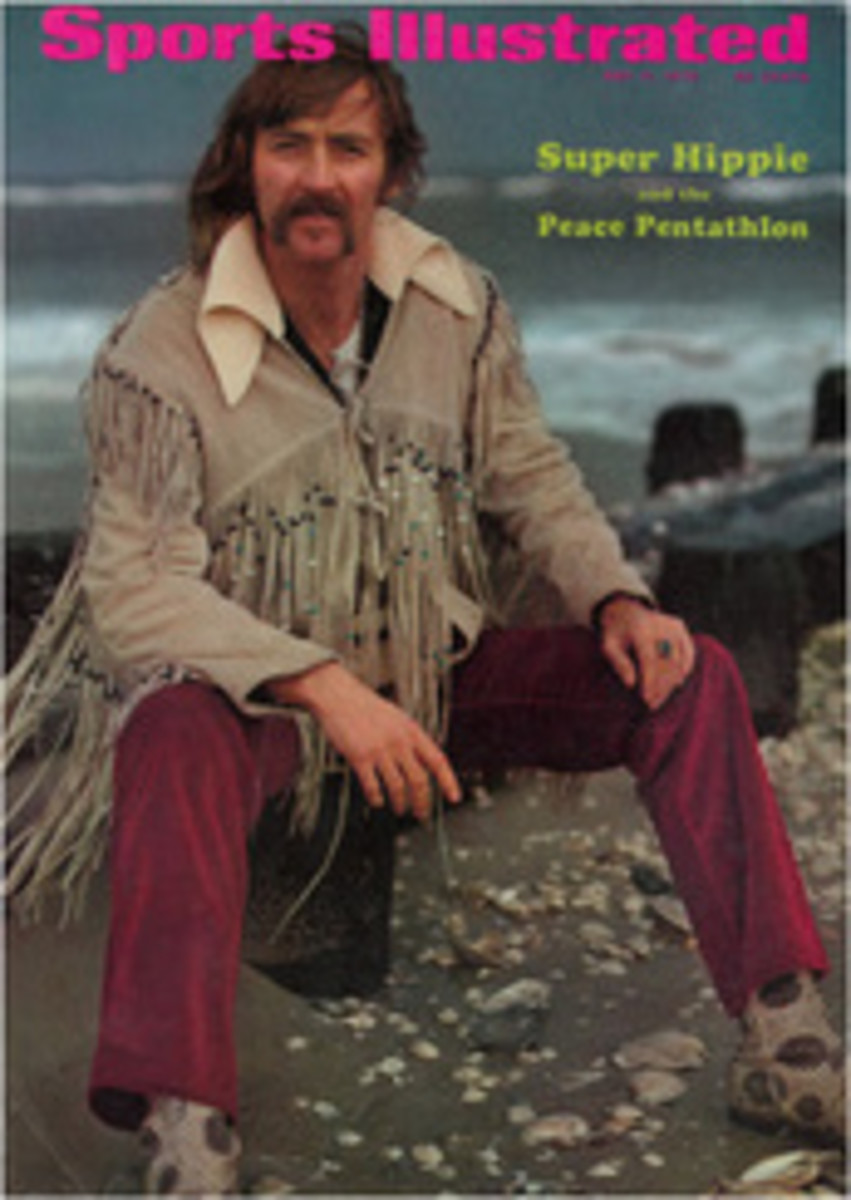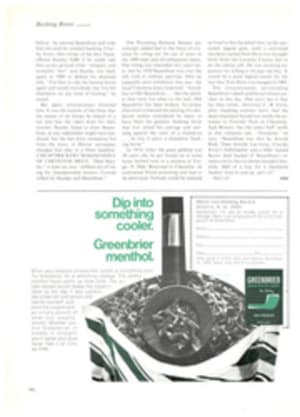
A Bucking Bronc That Was Not Known To Quit
Sooner or later, over six-shooter coffee or a six-pack of beer after the night's show is done on the rodeo trail, the argument will start again: which was the greatest bucking horse of all time? And except for a few stubborn holdouts who may still insist that a bronc named Midnight deserves the title, the consensus of any informal meeting of oldtimers will award it to Steamboat.
Steamboat was foaled in 1894 on the Foss Ranch in Wyoming and from the start made it perfectly clear that he was not destined to become a cow pony. Owner Frank Foss' 6-year-old son could lead the rawboned black colt around on a string, but no two husky ranch hands could ever hold him long enough to cinch a saddle on his back. Finally, in 1898, Foss decided that Steamboat could never be broken to the saddle, and after the horse had busted up a couple of good men he sold him to the Swan Land & Cattle Company, a big outfit running the Two Bar brand.
Promptly Steamboat hooked up in a spectacular go-round with the top Two Bar bronc buster. The cowboy rode him—momentarily—but became so enraged at the big black's furious bucking that he belted the horse brutally across the nose with the loaded butt of his quirt. That blow unwittingly created a legend of the West. Always thereafter, due to some undiagnosed and untreated obstruction of his breathing apparatus caused by the injury, the maltreated horse whistled like a riverboat whenever he went into action. In time he became known from the Rio Grande to the Canadian Rockies as "Steamboat—the whistlin' hoss."
To Sam Moore, the Two Bar foreman, any bronc that wouldn't make a good cutting horse was just so much dog meat cluttering up the corral. Sam was glad, therefore, when soon after the quirting incident his boss sold Steamboat to John Coble of Bosler, Wyo. Coble, a keen horseman, recognized Steamboat for what he was and entered him in one of the early Cheyenne Frontier Days rodeos. The big bronc easily won first-prize money of $50 and was off on his fabulous career.
Modern rodeo rules make it difficult to compare bronc riding of today with that of 1900. At that time there was no 10-second rule and the rider stayed up until he tamed his bronc or the bronc tamed him. Virtually everyone who dared ride Steamboat was thrown or gave up, since the fiery black was never known to quit in all his 15 years of competition. Even gelding failed to slow him down in the arena
There was a portion of ham in Steamboat and a lot of sportsmanship. He used to save all his energy until the blindfold was jerked off his face—there were no chutes then—and he never attempted to attack a thrown rider. Steamboat's style was unique. Rodeo buff Jack Bowers, now 80, describes it thus:
"I've seen 'em all for 65 years and I never saw a buckin' hoss to top Steamboat. First off, he was big and powerful—1,100 pounds—and tireless. Fact is, he was the closest thing to perpetual motion that ever wore hair. He'd start to squat when they threw the saddle on him and by the time the bronc buster was set in the stirrups Steamboat's belly'd be almost touchin' the arena dust. Then, the second they'd jerk that blindfold he'd explode! He'd bust out to the middle of the arena as if he wanted the stage all to himself and he'd put on the damnedest exhibition of sunfishing and windmilling I ever seen. His best trick was to swap ends between jumps and come down ker-slam on four ramrod legs. His head and forelegs would be twisted one way and his rump and hind legs another. When he was goin' all out, he seemed to be on a great big invisible pogo stick. Few men could stand that kind of battering without bleeding from the nose, and most became nauseated as well. Sometimes, no matter how tight a rider laced his buckin' corset, he'd wind up with broken ribs. Bronc riders are harder'n scrap iron, but ol' Steamboat put some of the toughest into the hospital for repairs."
From 1900 to 1908, at the height of Steamboat's career, only two men managed to stay aboard the big black for more than a few seconds apiece. One of them, Frank Stone, stayed up for 10 seconds in 1904 by pulling leather before being thrown hard. Frank later admitted that he had blacked out after the first few jumps and didn't remember a thing until he woke up on a blanket behind the stands. Curiously, his larynx was so affected by the ordeal that he couldn't speak above a whisper for a month.
None of Steamboat's many challengers fully rode him out until the Cheyenne show of 1908, although crack buster Guy Holt came close. In the 1908 Cheyenne event a muddy arena enabled Dick Stanley to ride the champion to a standstill. In those soggy circumstances Stanley did what no rider had ever done before—he spurred Steamboat and rode him out until he stopped bucking. Charley Irwin, then owner of the fiery black, offered Stanley $200 if he could ride him on dry ground while "whippin" and scratchin' him" and Stanley was back again in 1909 to defend his disputed title. "I'm here to ride the famous horse again and satisfy everybody that I'm the champion on any kind of footing," he stated.
But again, circumstances thwarted him. It was the custom of the times that the names of all horses be placed in a hat and that the riders draw for their mounts. Stanley failed to draw Steamboat, as any oddsmaker might have predicted, but the fact drew immediate fire from the press. A Denver newspaper charged foul play in a blunt headline: CHEAP TRICKERY MAKES FIZZLE OF CHEYENNE MEET. "Dick Stanley," it went on, was "jobbed out of riding for championship honors. Crowds yelled for Stanley and Steamboat."
The Wyoming Humane Society unwittingly added fuel to the blaze of criticism by ruling out the use of spurs in the 1909 meet and all subsequent meets. The ruling was rescinded two years later, but by 1910 Steamboat was over the hill, with or without spurring. After an especially poor exhibition that year, the local Cheyenne press lamented: "Goodbye to Old Steamboat...like the pitcher that went too often to the well, Old Steamboat has been broken. Yesterday afternoon witnessed the passing of a desperate outlaw considered by many to have been the greatest bucking horse that ever pitted his courage and cunning against the valor of a champion...he was 9 years a champion bucking horse."
In 1914, when the great gelding was 20 years old, he got fouled up in some loose barbed wire in a pasture at Fargo, N. Dak. Returned to Cheyenne, he contracted blood poisoning and had to be destroyed. Nobody could be induced or hired to fire the lethal shot, so the persistent legend goes, until a convicted murderer named Tom Horn was brought forth from the Laramie County Jail to do the odious job. He was awaiting execution for killing a 14-year-old boy. It would be a good legend except for the fact that Tom Horn was hanged in 1903.
The circumstances surrounding Steamboat's death and burial remain unclear to this day. One story has it that his then owner, showman C. B. Irwin, after shedding copious tears, had the dead champion buried just inside the entrance to Frontier Park in Cheyenne. Jack Bowers, the old rodeo buff, scoffs at this romantic tale. "Nonsense," he says. "Steamboat was shot by Arnold Rick. Then Arnold, Lee Gray, Charley Irwin's bullwhacker and a feller named Scotty Jack hauled ol' Steamboat's remains out to the city dump outside Cheyenne. Hell of a way for a champion buckin' hoss to end up, ain't it?"
Ain't it?

